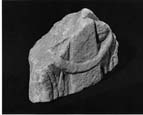Select a site alphabetically from the choices shown in the box below. Alternatively, browse sculptural examples using the Forward/Back buttons.
Chapters for this volume, along with copies of original in-text images, are available here.
Object type: Fragment of centre of cross-head [1]
Measurements: H. 17 cm (6.7 in); W. 26 cm (10.3 in); D. 11 cm (4.3 in)
Stone type: Coarse-grained, massive yellow sandstone
Plate numbers in printed volume: Pls. 81.412-414, 82.415
Corpus volume reference: Vol 1 p. 95-96
(There may be more views or larger images available for this item. Click on the thumbnail image to view.)
A (broad): Surrounded by an outer flat-band and a fine inner roll moulding. In the centre is the draped torso of a figure and what may be its draped left arm. The figure is crossed at about waist level by what seems to be the circular flat-band moulding of the cross centre, which corresponds to the roll-moulded border of the interlace roundel in the centre of face C. Below this moulding, on the left, is the tip of a spear, and, on the right, a cup-like feature on a stem.
B and D (narrow): Broken, probably plain.
C (broad): In the centre the remains of a raised roundel of interlace, surrounded by a roll moulding.
Face A seems to represent a Crucifixion, in which the figure of Christ is almost entirely enclosed in the cross-head. However, if the figure were of the very elongated draped type, as at Kirkdale or Kirkburton, both in Yorkshire, then it would intrude into the shaft. Like Finghall, Yorkshire, where only the spear and cup or sponge survive (Coatsworth 1979, II, 20-1, pl. 169), it seems reasonable to think that the spear-bearer and the cup- or sponge-bearer would have been present. They could, like Alnmouth, have been standing considerably below the figure of Christ. There is always some difficulty in fitting the pair alongside, rather than below, the figure of Christ (see Auckland St Andrew 1). Although there are Crucifixion scenes which include these figures (at Aycliffe, no. 1, and Alnmouth), the figure of Christ in the cross-head, and emphasized by a central boss or circle, is found at Brigham, Cumberland (Coatsworth 1979, I, 38-9, II, 15, pl. 52B), Lancaster (ibid., I, 37-8. II, 33-4, pls. 50-1), Stanwick (ibid., I, 135-6, II, 47, pl. 44) and Thornton Watlass, both in Yorkshire (ibid., I, 136-7, II, 49-50, pls. 46-7). The fine cutting of this fragment together with the same type of double moulding can hardly separate it too far from Hart 7. It could be that this is an early depiction of a type that became popular in the Anglo-Scandinavian area.



